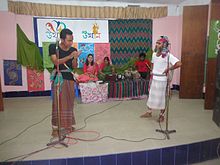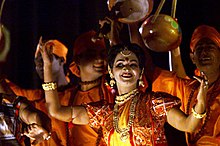You can help expand this article with text translated from the corresponding article in Bangla. (August 2019) Click [show] for important translation instructions.
|
| Gombhira | |
|---|---|
 | |
| Stylistic origins | Chapainawabganj, Maldah District |
 | ||||||
| Music of West Bengal | ||||||
| Genres | ||||||
|---|---|---|---|---|---|---|
|
||||||
| Specific forms | ||||||
|
||||||
| Media and performance | ||||||
|
||||||
|
|
||||||
| Regional music | ||||||
|
||||||
 | ||||||
| Music of Bangladesh | ||||||
| Genres | ||||||
|---|---|---|---|---|---|---|
| Specific forms | ||||||
|
||||||
| Media and performance | ||||||
|
||||||
| Nationalistic and patriotic songs | ||||||
|
||||||
| Regional music | ||||||
|
||||||
| Part of a series on the |
| Culture of Bengal |
|---|
 |
| History |
| Cuisine |
Gombhira, Gambhira or Gamvira (Bengali: গম্ভীরা) is a type of Bengali song and dance originating in the Bengal region, from what is known today as northwestern Bangladesh and north eastern West Bengal, India.[1][2][3][4][5]
In West Bengal (India), gombhira performances are centred around the Malda District whereas Chapai Nawabganj District is the main centre of Gambhira performances in Bangladesh. The tradition is also popular in the nearby districts of Rajshahi and Naogaon.[3] It is performed with a particularly distinctive rhythm and dance with two performers, always personifying a man and his maternal grandfather, discussing a topic to raise social awareness.
- ^ Bangladesh. Calaccitra o Prakāśana Bibhāga (1988). Bangladesh Quarterly, Volume 8. University of California. pp. 4–8.
- ^ A. F. Salahuddin Ahmed; Bazlul Mobin Chowdhury (2004). Bangladesh, national culture, and heritage: an introductory reader. Independent University, Bangladesh. pp. 407–410. ISBN 978-984-8509-00-5.
- ^ a b Don Rubin; Chua Soo Pong; Ravi Chaturvedi; Minoru Tanokura; Ramendu Majundar (2001). The World Encyclopedia of Contemporary Theatre: Asia/Pacific. Taylor & Francis. pp. 78–86. ISBN 9780415260879.
- ^ "Mango festival and cultural programme in Chapainawabganj". The Daily Star. 20 June 2009. Retrieved 2016-04-02.
- ^ "Rajshahi University School, College wins divisional round". The Daily Star. 9 August 2014. Retrieved 2016-04-02.